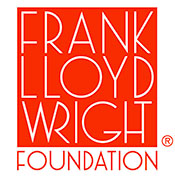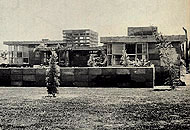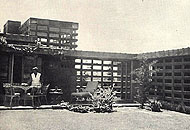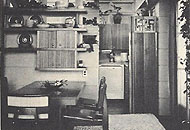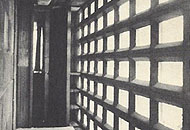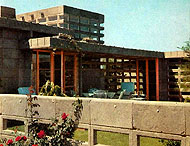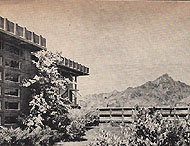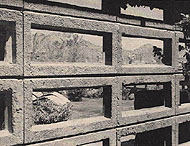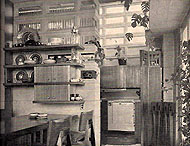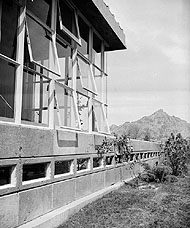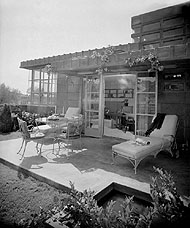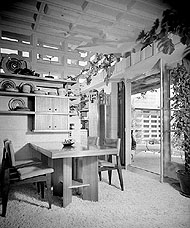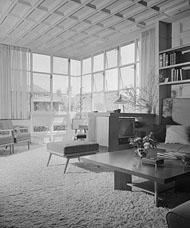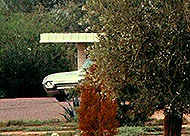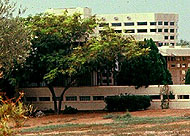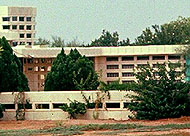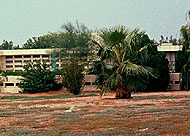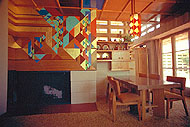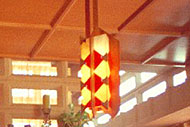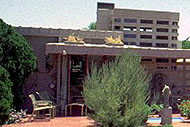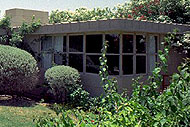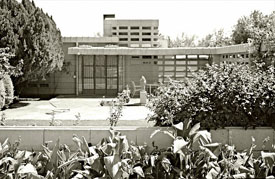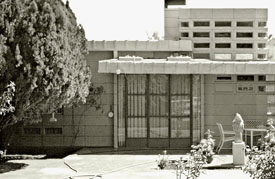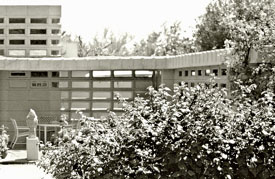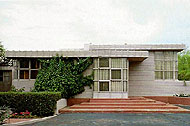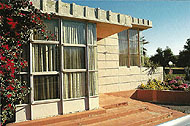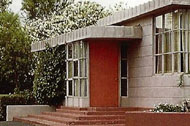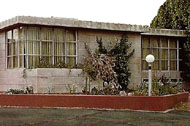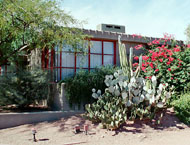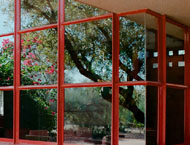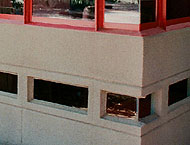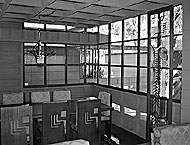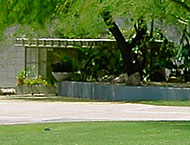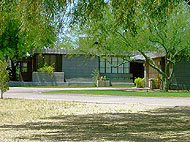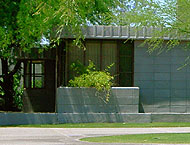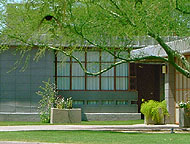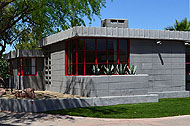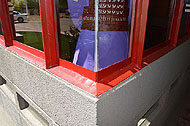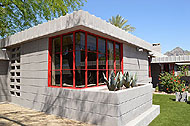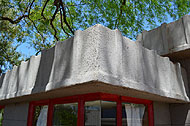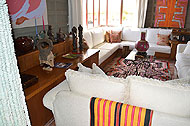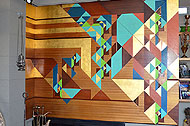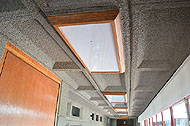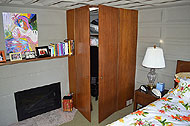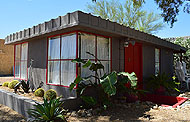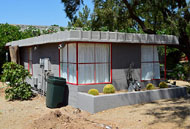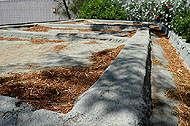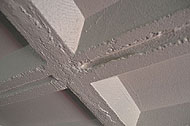|
|
|
|
Introduction
1) Adelman Laundry (P1945)
2) Albert Adelman #1
(P1946)
3) Benjamin Adelman (P1948)
4) Albert Adelman (1948)
5) Benjamin Adelman
(1951) 6) Benjamin
Adelman (P1954) Floor
Plan 1951 Natural House
(1954)
Arizona Highways (1956)
Maynard Parker (C 1953-54)
Remodel 1957
Adelman C1957
Adelman 1963
Adelman 1968
Adelman 1973
Adelman 1979
Adelman 1996
Adelman 2004
Adelman 2014
Adelman Interior 2014
Adelman Guest House 2014
Bibliography
Additional Albert
Adelman House Information... |
|
|
|
Introduction |
|
|
|
Frank Lloyd Wright designed three homes and a laundry facility
for Benjamin Adelman, and a home, two schemes for his son,
Albert Adelman. He was born in Russia in 1886 and immigrated
to the United States in 1903. He married his wife Regina in
1920. They had four children, Suren, Albert, Robert, and
Lucielle. Benjamin Adelman past away in April 1959.
1) Adelman Laundry (Project 1945). Wright's first project for Benjamin Adelman was a
commercial building for his laundry and dry-cleaning
business in Milwaukee in 1945. The two-story structure was
designed for an irregular shaped lot. The design was
very advanced for its time. Half of the second floor and the
long balcony, cantilevered over parking and a drive-through window.
The large workroom on the second floor, designed with a
plenum ceiling for handling large amounts of steam, was
bordered with a row of clerestory windows, The building also
included private offices, fur storage and employee dining
room. Before it was built, they had a change in business
plans, and it was never built. The plans remained a project.
(FLLW #4507).
2) Albert Adelman House, Scheme #1
(Project 1946). One year after Frank Lloyd Wright began the design for the
laundry facility, Benjamin's son Albert, approached Wright
about designing a home for him on a lot he owned in Fox
Point, Wisconsin, ten miles North of downtown Milwaukee,
which is on the shores of Lake Michigan. It was an "L"
shaped plan, one wing for the bedrooms with the master
bedroom at the corner of the "L", and Living, Dining and
Kitchen in the other wing. The Living Room featured a two
story room with a Library/Balcony overlooking the living
room, topped with a sun deck. The plan included a
tennis court and swimming pool. This version was redesigned
as Scheme #2 in 1948. (FLLW #4801).
3) Benjamin Adelman House (Project
1948). Frank Lloyd Wright designed a beautiful home on a
bluff overlooking Lake Michigan in Fox Point, Wisconsin. The
home was to be constructed of concrete walls, much like
Taliesin West, broad cantilevered roof lines, and a balcony
facing the lake, cantilevered out over the bluff. This home
was never built, and remains a project. (FLLW #4802).
4) Albert Adelman House, Scheme #2
(1948 - S.308). Frank Lloyd Wright modified his first
design, straightening out the "L", and removing the
Library/Balcony and Sun Deck above the Living Room. It was
constructed of concrete block, cypress and cedar shakes.
This was the first completed Wright design for the Adelman
family. (FLLW #4834).
|
|
5) Benjamin Adelman
House, Phoenix, AZ (1951 - S.344). This home is
considered to be the first
Usonian Automatic House designed by Frank Lloyd Wright.
In 1936, Wright developed a series of homes he called
Usonian. They were designed to control costs. He continued
to develop the concept, and in the early 1950s he first used
the term Usonian Automatic to describe a Usonian style house
made of inexpensive concrete blocks. The modular blocks
could be assembled in a variety of ways. Wright hoped that
home buyers could save money by building their own Usonian
Automatic houses. A precursor to the Usonian Automatic
system were the four Textile Block homes in California,
Millard (La Miniatura) S.214, Storer S.215, Freeman S.216,
and the Ennis S.217.
The basic concrete block of the Usonian
Automatic system is 12 x 24 inches, and comes in a variety
of styles: plain for the walls; coffered, creating a waffle
pattern; perforated, with and without glass.
This home is actually two separate
buildings connected by a covered walkway, with a perforated
wall on the south side. The seven hundred square foot
primary quarters included
the Living and Dining Rooms, Workspace (kitchen) and Master
Bedroom and Bath. The Living Room featured a geometric wall
mural above the fireplace, designed by Eugene Masselink. The secondary
five hundred square foot guest house to the West
included the Maid's Bedroom and Bath, Guest Room, Bath and a
Sitting Room with a fireplace.
Adelman wintered at the Arizona Biltmore,
which is adjacent to the western boundary. Just to the north
is the Boomer Residence.
Frank Lloyd Wright wrote "Here then,
within moderate means for the free man of our democracy,
worth some intelligence and by his own energy, comes a
natural house designed in accordance with the principles of
organic architecture."
A Natural House,
Wright, 1954,
p.205. Adelman past away in April 1959, and the home was sold
soon after.
(FLLW #5101).6) Benjamin Adelman House, Whitefish
Bay, Wisc. (Project 1954). The basic floor plan for this
home was the plan from the 1953 New York Exhibition House
with the addition of a second story. Hand written on the
perspective drawing, "Dear Father Adelman - This is how
it would look from the street - The plan of the main floor
is the New York exhibition house plus a second story for
servants. FLLW." Wright, 1943 - 1959, Pfeiffer,
p.350. Although this home was never built, the New York
Exhibition House was built for the
Triers in Iowa, in 1956. (FLLW #5501). |
|
|
|
|
|
|
1) Adelman Laundry, Milwaukee, (Project 1945) |
|
|
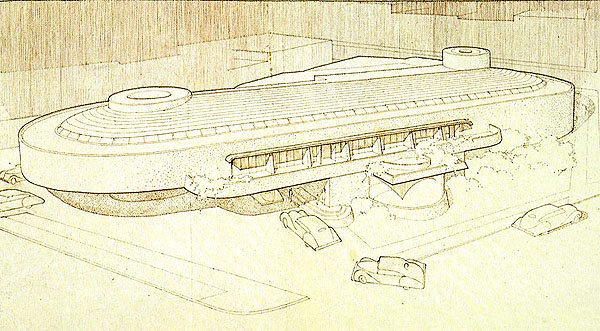 |
|
1) Adelman Laundry (Project 1945).
Wright's first project for Benjamin Adelman was a commercial
building for his laundry and dry-cleaning business in
Milwaukee in 1945. The two-story structure was designed for
an irregular shaped lot. The design was very advanced for its time.
Half of the second floor and the long balcony, cantilevered
over parking and a drive-through window.
The large workroom on the second floor, designed with a
plenum ceiling for handling large amounts of steam, was
bordered with a row of clerestory windows, The building also
included private offices, fur storage and employee dining
room. Courtesy of the Frank Lloyd Wright Foundation. |
|
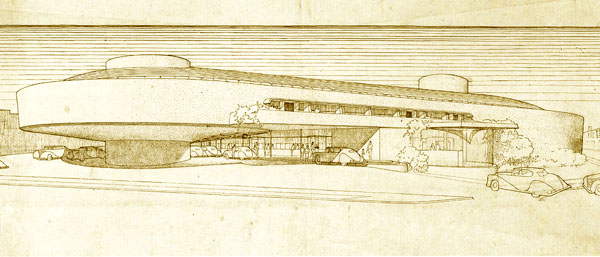 |
|
|
|
|
|
|
|
|
2) Albert Adelman Home, Scheme
#1 (1946) |
| |
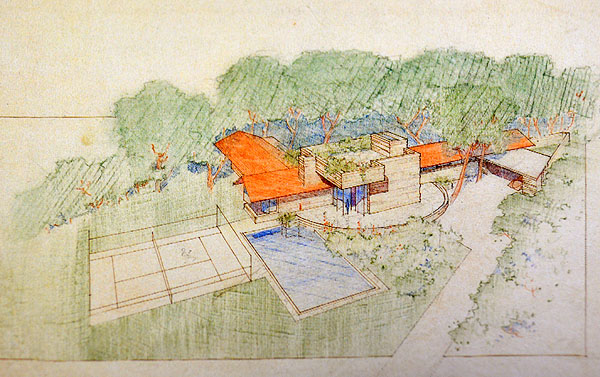 |
|
2) Albert Adelman House, Scheme #1 (Project 1946).
One year after Frank Lloyd Wright began the design for the
laundry facility, Benjamin's son Albert, approached Wright
about designing a home for him on a lot he owned in Fox
Point, Wisconsin, ten miles North of downtown Milwaukee,
which is on the shores of Lake Michigan. It was an "L"
shaped plan, one wing for the bedrooms with the master
bedroom at the corner of the "L", and Living, Dining and
Kitchen in the other wing. The Living Room featured a two
story room with a Library/Balcony overlooking the living
room, topped with a sun deck. The plan included a tennis
court and swimming pool. Courtesy of the Frank Lloyd Wright
Foundation. |
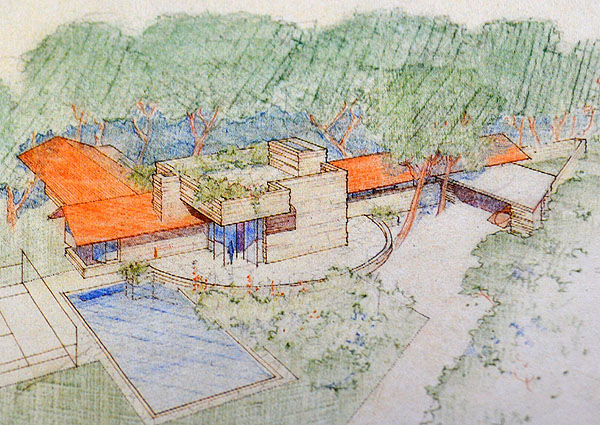 |
|
Detail of the Albert Adelman House, Scheme #1. |
| |
| |
| |
|
|
3) Benjamin Adelman House, (Project
1948) |
| |
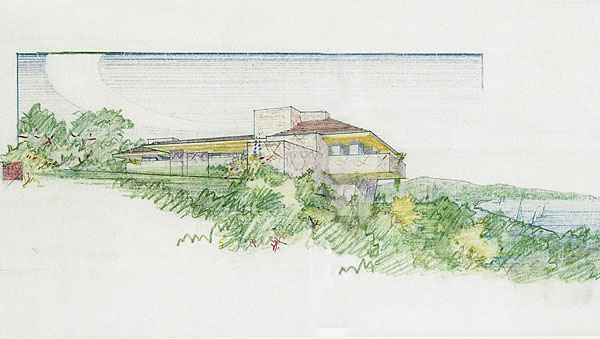 |
|
3) Benjamin Adelman House (Project
1948). Frank Lloyd Wright designed a beautiful home on a
bluff overlooking Lake Michigan in Fox Point, Wisconsin. The
home was to be constructed of concrete walls, much like
Taliesin West, broad cantilevered roof lines, and a balcony
facing the lake, cantilevered out over the bluff. This home
was never built, and remains a project. Courtesy of the
Frank Lloyd Wright Foundation. |
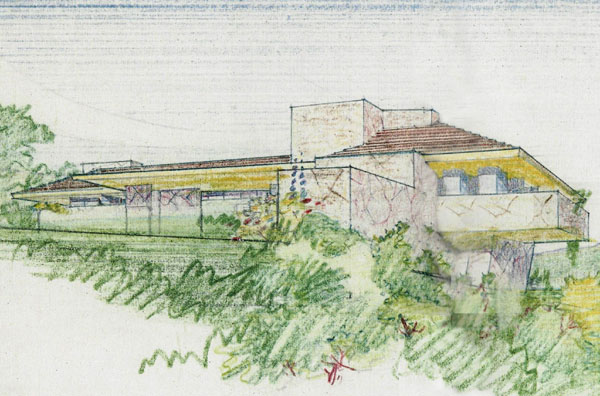 |
|
Detail of the Benjamin Adelman House (Project 1948). |
| |
| |
| |
|
|
4) Albert Adelman House, Scheme #2 (1948 - S.308) |
| |
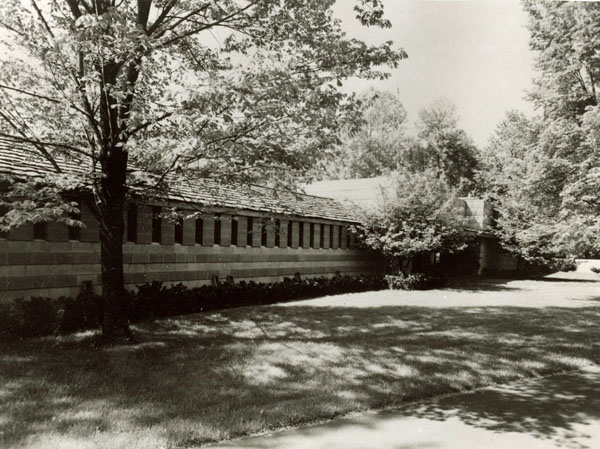 |
4) Albert Adelman House, Scheme #2 (1948 - S.308).
Frank Lloyd Wright modified his first design, straightening
out the "L", and removing the Library/Balcony and Sun Deck
above the Living Room. It was constructed of concrete block,
cypress and cedar shakes. This was the first completed
Wright design for the Adelman family. Courtesy of the
Milwaukee Public Library.
Additional Albert Adelman House
Information... |
| |
| |
| |
|
|
5) Benjamin Adelman House, Phoenix, AZ
(1951 - S.344) |
| |
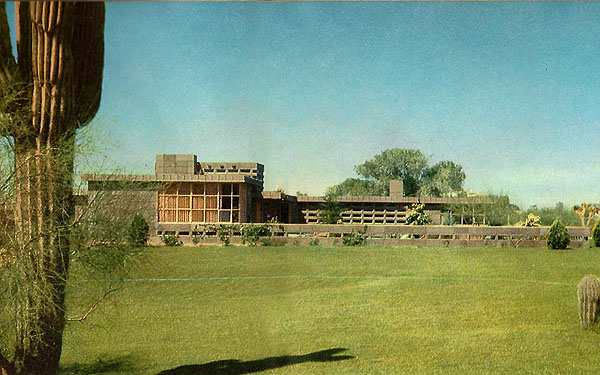 |
|
5) Benjamin Adelman
House, Phoenix, AZ (1951 - S.344). Viewed from the east,
circa 1955. The Living Room is in the foreground on the
left, the guest house is in the background to the right. The
Arizona Biltmore can be seen in the background to the fare
right. This home is
considered to be the first
Usonian Automatic House designed by Frank Lloyd Wright.
This home is actually two separate buildings connected by a
covered walkway, with a perforated wall on the south side.
The seven hundred square foot primary quarters included the
Living and Dining Rooms, Workspace (kitchen) and Master
Bedroom and Bath. The secondary
five hundred square foot guest house to the West
included the Maid's Bedroom and Bath, Guest Room, Bath and a
Sitting Room with a fireplace. Frank Lloyd Wright wrote "Here then,
within moderate means for the free man of our democracy,
worth some intelligence and by his own energy, comes a
natural house designed in accordance with the principles of
organic architecture."
A Natural House,
Wright, 1954,
p.205. Courtesy of the
Arizona
Highways, February 1956. |
| |
| |
| |
|
|
6) Benjamin Adelman House, Whitefish
Bay, Wisc. (Project 1954) |
| |
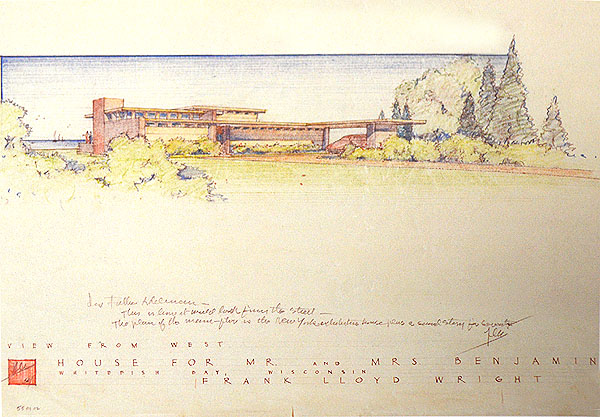 |
|
6) Benjamin Adelman House, Whitefish
Bay, Wisc. (Project 1954). The basic floor plan for this
home was the plan from the 1953 New York Exhibition House
with the addition of a second story. Hand written on the
perspective drawing, "Dear Father Adelman - This is how
it would look from the street - The plan of the main floor
is the New York exhibition house plus a second story for
servants. FLLW." Wright, 1943 - 1959, Pfeiffer,
p.350.
Courtesy of the Frank Lloyd Wright Foundation. |
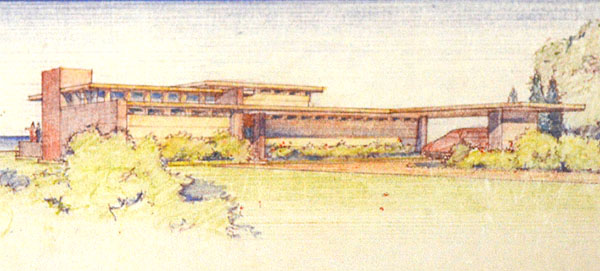 |
|
Detail of the Benjamin Adelman House (Project 1954). |
| |
| |
| |
|
|
Floor Plan Benjamin Adelman House (1951 -
S.344) |
|
|
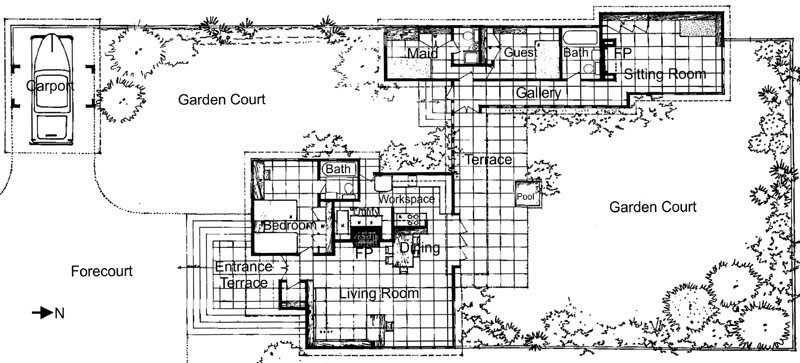 |
|
Floor plan for the Benjamin
Adelman House, 1951. Courtesy of "A Natural House",
Wright, 1954,
Two separate buildings are connected by a covered
walkway, with a perforated wall on the south side. The
Garden Courts are enclosed by a block wall. The seven
hundred square foot primary quarters included the Living and
Dining Rooms, Workspace (kitchen), Master Bedroom and Bath.
The secondary five hundred square foot guest house to the
West included the Maid's Bedroom and Bath, Guest Room, Bath
and a Sitting Room with a fireplace.
Text adapted by
Douglas M. Steiner. |
|
|
|
|
|
|
|
|
Benjamin Adelman Residence - "The
Natural House" (1954) |
|
|
|
This home is
considered to be the first
Usonian Automatic House designed by Frank Lloyd Wright.
In 1936, Wright developed a series of homes he called
Usonian. They were designed to control costs. He continued
to develop the concept, and in the early 1950s he first used
the term Usonian Automatic to describe a Usonian style house
made of inexpensive concrete blocks. The modular blocks
could be assembled in a variety of ways. Wright hoped that
home buyers could save money by building their own Usonian
Automatic houses. A precursor to the Usonian Automatic
system were the four Textile Block homes in California,
Millard (La Miniatura) S.214, Storer S.215, Freeman S.216,
and the Ennis S.217. |
|
The basic concrete block of the Usonian
Automatic system is 12 x 24 inches, and comes in a variety
of styles: plain for the walls; coffered, creating a waffle
pattern; perforated, with and without glass.
This home is actually two separate
buildings connected by a covered walkway, with a perforated
wall on the south side. The seven hundred square foot
primary quarters included the Living and Dining Rooms,
Workspace (kitchen) and Master Bedroom and Bath. The Living Room featured a geometric wall
mural above the fireplace, designed by Eugene Masselink. The secondary
five hundred square foot guest house to the West
included the Maid's Bedroom and Bath, Guest Room...
Continue... |
|
|
|
|
|
|
Benjamin Adelman Residence (1954-55): "Arizona
Highways" (February 1956) |
|
|
Five photographs and a floor
plan of the Benjamin Adelman House was published in the
February 1956 issue of the
Arizona
Highways.
This home is
considered to be the first
Usonian Automatic House designed by Frank Lloyd Wright.
This home is actually two separate buildings connected by a
covered walkway, with a perforated wall on the south side.
The seven hundred square foot primary quarters included the
Living and Dining Rooms, Workspace (kitchen) and Master
Bedroom and Bath. The secondary five hundred square foot
guest house to the West included the Maid's Bedroom and
Bath, Guest Room, Bath and a Sitting Room with a fireplace. |
|
Window and door casings were
painted cherokee red. Perforated blocks were used throughout
the house. A low band of perforated blocks began in the Living Room and
continued along the eastern Garden Court wall,
then halfway along the Northern wall. Only the Living Room
blocks were glazed with Glass. The upper walls of the
Workspace were also perforated and glazed. The Southern wall
of the walkway was perforated, but not glazed. The Eastern
wall of the Guest House Gallery was perforated and glazed.
These five photographs
most likely taken in 1954-5....
Continue... |
|
|
|
|
|
|
Benjamin Adelman Residence - By Maynard
Parker (Circa 1953-54) |
| |
Although the Benjamin Adelman
was the first
Usonian Automatic House designed by Frank Lloyd Wright,
it was not the first to be built. In 1952, one year after
designing the Adelman house, Wright design the second
Usonian Automatic for Arthur Pieper, an apprentice, who also
became his son-in-law on June 18, 1954. Pieper built his
home in early 1952.
Designed in 1951, the home was not built
until 1953. Benjamin Adelman purchased a lot and a half from
Jorgine Boomer. "For the consideration of Ten Dollars, and
other valuable considerations, I, Jorgine Boomer, a widow,
do hereby |
|
convey to Benjamin E. Adelman
and Regina B. Adelman, his wife..." Warranty Deed, March 30,
1953.
Construction on the Adelman House began in 1953, and was most likely completed in
late 1953 or early 1954.
This set of 15 photographs were taken after
the home was completed and landscaped, and most likely in
late 1953 or early 1954. They were either published in "A Natural House,"
Wright, 1954, or taken approximately at the same time.
Five were published in the November 1955
issue of House Beautiful.
Continue... |
| |
|
|
Benjamin Adelman Residence Remodel 1957 |
| |
|
Left: Original Floor plan for the Benjamin
Adelman House, 1951. Courtesy of "A Natural House",
Wright, 1954, Two separate buildings are connected by a covered
walkway, with a perforated wall on the south side. The
Garden Courts are enclosed by a block wall. The seven
hundred square foot primary quarters included the Living and
Dining Rooms, Workspace (kitchen), Master Bedroom and Bath.
The secondary five hundred square foot guest house to the
West included the Maid's Bedroom and Bath, Guest Room, Bath
and a Sitting Room with a fireplace. Although not indicated
on the drawing, a utility room was added and enclosed on the
west side of the carport, and carport...
Continue... |
|
Right: In 1957, Adelman contacted
Wright to enlarge his cottage. The Living Room was expanded
to the South and East, with a planting box on the Southeast
Corner. The Master Bedroom was expanded to the South, and
the Master Bath was enlarged and expanded to the West. The
Entrance was also moved to the South but the door was moved
from the South to the East. The original stairs were removed
and also expanded to the South. They were also widened from
12 to 16" wide. The Maid's Room in the Guest Wing was
converted to a Bedroom, and a closet was added to the
Sitting Room and used as a Bedroom. The doors of the closet
formed the corner when closed...
Continue... |
|
|
|
|
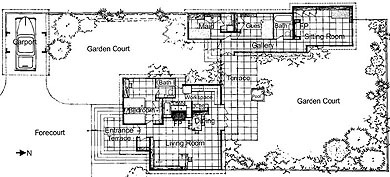 |
|
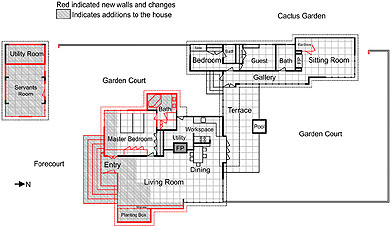 |
| |
| |
| |
|
|
Benjamin Adelman Residence - By Maynard
Parker (Circa 1957-58) |
|
|
|
|
|
Photograph of the Fireplace,
circa 1957-58.
One major change is the wood ceiling. The coffered blocks
have been covered. Although the trim follows a two foot
square pattern. The pottery on the shelves is the same as the 1953-54 image
#12, but rearranged. Besides documenting the
fireplace, this image reveals its original details and
colors. The walls are painted a light pink. The chair seats
and backs are a red vinyl. A clue to the paneled
ceiling could be a note written on the plans for the 1957
remodel. "Note: Cover all inside faces of all exterior walls
and ceilings with 3/8" waterproof finish plywood, veneered
on exposed face with...
Continue... |
|
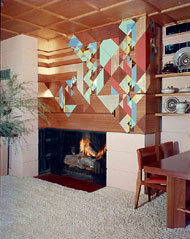 |
| |
|
|
| |
|
|
| |
|
|
|
|
Benjamin Adelman Residence (1963) |
|
|
|
|
|
Sadly, after
enjoying his home for only eight years, Benjamin Adelman
past away in 1959. Soon after his death, the home was sold to a
private party. The landscaping is mature, around 12 year
old. Although much of the home is blocked in this view,
details are visible. The carport roof is held up with four
block piers and cantilevers out about six feet. The Living
Room is on the left, the curtains are drawn. The fireplace
chimney can be seen above |
|
the trees. The Workspace can be
seen above the trees. The covered walkway has not been
enclosed yet. Two planter boxes on the left side of the
covered walkway are still there, although it doesn't appear
to hold any plant. The Gallery's perforated blocks are
glazed with glass, forming a glass-block wall. Curtains have
been added and they are drawn. The Sitting Room, converted
to a Bedroom is on the right. The curtains...
Continue... |
|
|
Benjamin Adelman Residence - By William
Storrer (1968) |
| |
|
|
|
Set of three photographs of the Benjamin
Adelman Residence by William Storrer, circa 1968. The
exterior view is from the North. The landscaping is very
mature, 17 years old. The Walkway has not yet been enclosed.
The Master Bath that was enlarged in the 1957 remodel can be
seen threw the perforated blocks as can the carport to its
right. The Terrace, which used to end at the middle of the
small pool (Parker 1953 #6), has been
enlarged to the North approximately 20 feet. |
|
The Living Room fireplace was designed by
Eugene
Masselink. The original coffered block ceiling, with 1 foot
x 2 foot embedded blocks, has been covered with mahogany
plywood. The trim follows a two foot square pattern. Storrer indicated that furniture and the Wright designed
chandelier was sold in the late 1980s.
The Workspace's lower mahogany cabinets appear to be recovered with a
laminate. Upper...
Continue... |
| |
|
|
|
|
Benjamin Adelman Residence - By Anthony
Thompson (1973) |
| |
|
|
|
Benjamin Adelman Residence
viewed from the North, 1973. The landscaping is very mature,
22 years old. The large trees on the left have overtaken the
Living Room, blocking the view of Piestewa (Squaw) Peak. The
Living Room is on the far left. The Dining area is in the
center. The is one of the best exterior views of the dining
area to date. The tall Workspace is seen in the center
background. The covered walkway runs from the Dining area
glass |
|
doors on the left, to the Guest House on the right. The
Walkway has not yet been enclosed. The perforated block wall
on the right side of the walkway is left unglazed with
glass. The Terrace, which used to end at the middle of the
small pool (Parker 1953 #6), has been
enlarged to the North approximately 20 feet. The Guest Wing
is on the far right. The perforated blocks of the Gallery
are glazed. Two planter boxes on the left side...
Continue... |
| |
|
|
|
|
|
Benjamin Adelman Residence - By Thomas A.
Heinz (Circa 1979) |
| |
|
|
|
Set of three photographs of the
Benjamin Adelman Residence by Thomas A. Heinz, circa 1979.
Photographed approximately 22 years after Frank Lloyd
Wright's 1957 remodel. The Master Bedroom was extended four
feet South. The Entrance, which originally faced South, now
faces East, and is enclosed on the South with glass. The
Living Room was extended 10 feet South in 1957. Windows were
added to the Southeast corner, as well |
|
as the built-in planter. A short
wall has been added to the left side of the stairs. The
short wall on the right appears to be a large planter box
turned at 45 degrees.
On Wright's 1957 plans, a "Servants Room"
was added to the West end of the Carport. It appears that
the Carport was enclosed instead, and windows added to each
corner, as well as the addition of the built-in planter
on...
Continue... |
| |
|
|
|
|
Benjamin Adelman Residence - By Anthony
Thompson (1996) |
| |
|
|
In 1988, a major renovation and
addition was completed by Fred Bloch, an architect who had
worked under Edgar Tafel. The 1957 Entrance, originally on
the South, which lead into the Living Room, was blocked off
and replaced with perforated/glazed blocks. The entry stairs
were removed. The Entrance was moved to the North side of
the Living Room, and opened into a hallway.
Originally white or silver, window cames
were painted Cherokee red. The roof of the covered walkway,
intersected the Workspace wall, and ended just past the
doors that lead to the Terrace. It was extended over the new
Entrance, and continued to the East joining the new garage. |
|
Originally the main house ended at the work
space, and the cantilevered covered walkway was open. The
Walkway was enclosed with a glass wall.
The coffered ceiling blocks in the Living
Room, originally 1' by 2', were replaced with 2'
by 2' blocks. The roof of the covered walkway, which intersected the
Workspace wall, and ended just past the doors that lead to
the Terrace, was extended over the new Entrance, and
continued to the East joining the new garage. The
decorative edge of the roof with the 1' square pattern was
retained.
Dining table and chairs were...
Continue... |
| |
|
|
|
|
Benjamin Adelman Residence - By Douglas M.
Steiner (April 2004) |
| |
|
|
In April, 2004 we had the
opportunity to visit the Scottsdale area and view a number
of Frank Lloyd Wright homes from a distance. The few views
offer a glimpse of what remains of Wright's 1957 remodel,
and a view of the major revisions by Fred Bloch.
The 1957 entrance, originally on the South
side of the house (left), has been blocked off and replaced
with perforated/glazed blocks. The entry stairs that were on
the left, have also been removed. The Entrance has been
moved to the right side of |
|
the Living Room. Perforated
blocks have been added to the fireplace chimney. The 1957
Living Rooms windows and built-in planter box remain intact. Glass corners
are mitered.
The original Carport is now enclosed. In
1957, Frank Lloyd Wright proposed an addition to the back of
the Carport, to be used the "Servant's Room." Instead, it
appears the the Carport was enclosed instead. Windows were
added to the two front corners. The
Living Room was extended...
Continue... |
| |
|
|
|
|
Benjamin Adelman Residence - By Douglas M.
Steiner (April 2014) |
| |
|
|
|
Time flies. It had
been ten years since we last visited Scottsdale.
This trip had three purposes. The first was to visit
our youngest son and his wife, who reside in the
Phoenix area. The second was to visit Taliesin West
and personally meet and thank those that had
assisted us in publishing "Frank Lloyd Wright's
Nakoma Clubhouse & Sculptures." The third was a
desire to study and document Frank Lloyd Wright's
work, in a more in-depth way then just the cursory
drive by, clicking a few quick pictures (like in
2004). |
|
We had that opportunity at the Adelman
Residence. The owners were very gracious and allowed
us not only to closely view the exterior, but also
the interior.
Frank Lloyd Wright designed the home in
1951 as a summer cottage. In 1957, Wright enlarged
the Living and Master Bedroom of the main house. In
1988, the main home was extensively
renovation and enlarged to the North by Fred Bloch,
an architect who had worked under Edgar Tafel. The
main house and guest wing were also joining...
Continue... |
| |
|
|
|
|
|
|
|
|
|
Bibliography |
|
|
|
"The
Natural House",
Wright, 1954. |
|
"Arizona
Highways", February, 1956, pp 20-21, 24-25. |
|
"House
Beautiful", November 1955, pp 317-318. |
|
"Frank
Lloyd Wright: Three Quarters of a Century of Drawings",
Izzo; Gubitosi, 1976, Plate 149. |
|
"Frank
Lloyd Wright, His Life and His Architecture", Twombly,
1979, p337. |
|
"Treasures
of Taliesin", Pfeiffer, 1985, pp 32-33. |
|
"Frank Lloyd
Wright Monograph 1942-1950", Vol. 7, Text: Pfeiffer;
Edited and Photographed: Futagawa, 1990, pp 89, 124-124, 402. |
|
"Frank Lloyd
Wright Monograph 1951-1959", Vol. 8, Text: Pfeiffer;
Edited and Photographed: Futagawa, 1990, pp 14-15, 142. |
|
"Architectural
Monographs No 18: Frank Lloyd Wright",
Heinz, 1992, p.131. |
|
"The
Frank Lloyd Wright Companion", Storrer,
1993, p 366. |
| "Frank
Lloyd Wright, West", Heinz, 1994,
p54. |
|
"Frank
Lloyd Wright, Field Guide, West Vol 3", Heinz, 1999, p
77. |
|
"Frank
Lloyd Wright: The Western Work", Legler, 1999, pp
52-57. |
| "The
Vision of Frank Lloyd Wright",
Heinz, 2000, p.239. |
|
"Frank Lloyd
Wright, Complete Works 1943-1959", Pfeiffer; Gossel,
2009, pp ___, 150. |
|
"Frank
Lloyd Wright Designs, The Sketches, Plans and Drawings",
Pfeiffer, 2011, pp120-123, 380-383. |
| |
| |
| |
|
|
|

